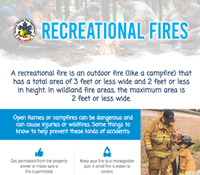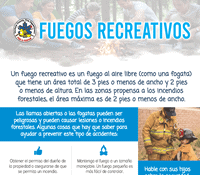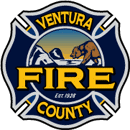Recreational Fire Safety
Be Safe in the Great Outdoors
A recreational fire is defined as an outdoor fire (such as a campfire) covering a total area of three feet or less wide and no more than two feet in height. In wildland fire areas, the maximum area is two feet wide. Even though these fires may be smaller, they’re still powerful fires—and inherently pose serious dangers to people, property, animals, and environments. If they break containment, they can easily and quickly spark a much larger–and much more dangerous–wildfire. To help prevent any serious repercussions with a recreational fire, follow these helpful tips.
- Obtain permission from the property owner or make sure a fire is permitted
- Keep your fire to a manageable size
- Clear away flammable vegetation such as leaves and sticks, overhanging low branches, and shrubs
- Maintain at least 25 feet of separation from structures and combustibles
- Don’t leave the fire unattended at any time
- Keep a bucket of water, fire extinguisher, shovel, or garden hose nearby
- Extinguish the fire by pouring lots of water on it—until all hissing sounds stop and all embers have been drowned out. Continue to add water and stir with a shovel until all material has cooled.
- Never burn trash, rubbish, garbage, or yard waste—this is all illegal activity
Download our helpful recreational fire safety flyer in English or Spanish now.
For additional information, view our Recreational Fire Safety Guidelines.
Teach Your Children Well
It’s not enough for adults to do their part to ensure safe recreational fires. Talk to your kids about fire safety—and what they can do to help prevent larger fires. Store any matches and lighters in your home in a safe, secure, out-of-reach place. If any clothing ever catches fire, teach them to always stop, drop, and roll. Tell them to drop to the ground and cover their face with their hands—and roll over or back and forth until the fire is extinguished.




